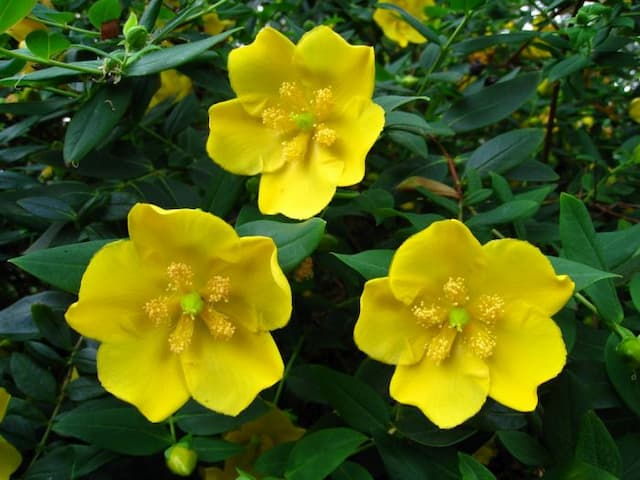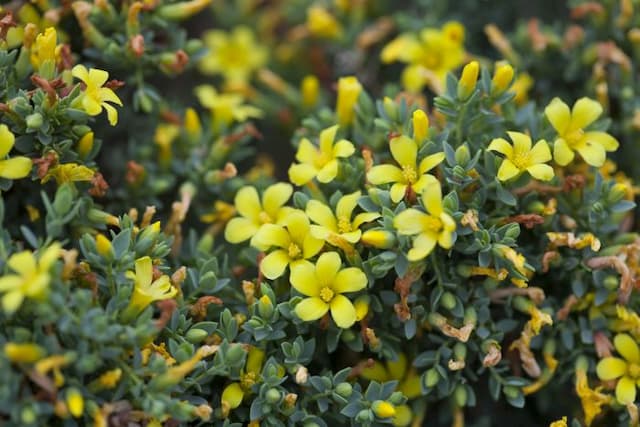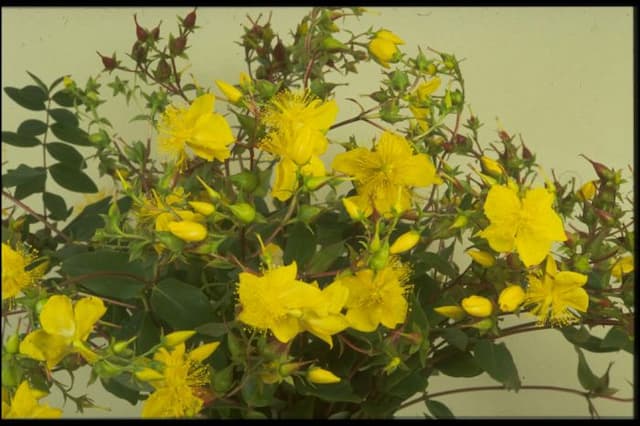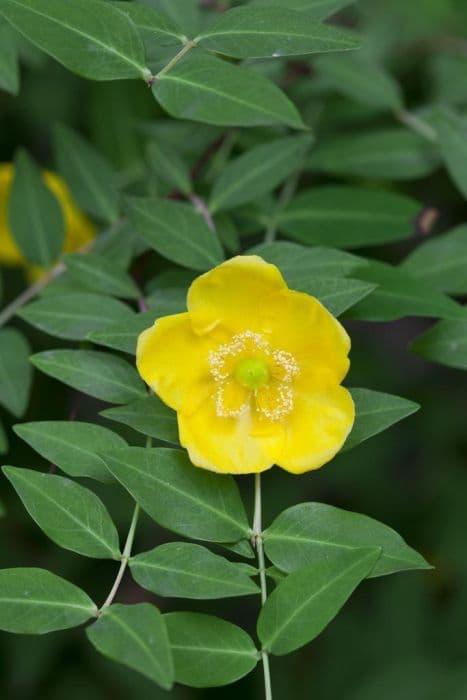St John's Wort Hypericum Miracle Blizz = 'Allblizz' (Miracle Series)

ABOUT
A compact, deciduous, rounded shrub, semi-evergreen in mild winters, to 1m tall, with ovate dark green leaves and shallow, cup-shaped, rich golden-yellow flowers with prominent central yellow stamens, from early summer into autumn; profuse white fruits follow
About this plant
 Names
NamesFamily
Hypericaceae
Synonyms
St. John's Wort, Hypericum
Common names
Hypericum 'Allblizz'
 Characteristics
CharacteristicsLife cycle
Perennials
Foliage type
Deciduous
Color of leaves
Green
Flower color
Yellow
Height
1-2 feet (30-60 cm)
Spread
1-2 feet (30-60 cm)
Plant type
Shrub
Hardiness zones
5
Native area
Cultivar
Benefits
 General Benefits
General Benefits- Attractive Flowers: Hypericum 'Allblizz' produces vibrant yellow flowers that add color and visual interest to gardens.
- Drought Tolerance: Once established, it requires minimal watering, making it suitable for drier climates or water-wise gardens.
- Easy Care: It is known for being low maintenance, requiring little pruning or other care, which is ideal for busy gardeners.
- Adaptable to Soil Types: This plant can thrive in a variety of soil conditions, from sandy to clay, making it versatile for different garden settings.
- Pest Resistance: It exhibits a natural resistance to many common garden pests, reducing the need for chemical interventions.
- Extended Blooming Period: Its blooming season extends through summer and often into early fall, providing a long display of flowers.
- Cold Hardy: It can withstand cold temperatures, making it a good choice for gardens in cooler climate zones.
- Wildlife Attraction: The flowers attract pollinators such as bees and butterflies, which are beneficial for the garden ecosystem.
- Compact Growth: With a contained growth habit, it is suitable for small spaces, borders, and container gardening.
- Evergreen Foliage: In milder climates, the plant may retain its leaves year-round, providing winter interest in the garden.
 Medical Properties
Medical PropertiesThis plant is not used for medical purposes.
 Air-purifying Qualities
Air-purifying QualitiesThis plant is not specifically known for air purifying qualities.
 Other Uses
Other Uses- St. John's wort can be used as a natural fabric dye, imparting a range of colors from yellow to red depending on the mordant used.
- The oil extracted from the flowers of St. John's wort can be used in homemade skincare, particularly in soothing balms for sensitive skin.
- Dried St. John's wort can be incorporated into potpourri mixtures, adding a subtle, earthy fragrance to your home.
- The flowers can be used to enhance the aesthetic of garden-inspired art projects, such as pressed flower crafts or botanical papermaking.
- St. John's wort serves as a useful plant for teaching botany or plant photography, with its clear, easily observed reproductive parts.
- You can use the plant for natural insect control in the garden as some species can deter certain pests.
- The vibrant yellow flowers are great for decorating and garnishing in culinary settings, for adding color to salads and desserts.
- St. John's wort can be used in landscape gardening to create visually appealing borders or as a ground cover due to its dense growing habit.
- Add the dried plant to a dream pillow to promote a calm environment for sleep, though effects are anecdotal and not scientifically proven.
- St. John's wort can be used as part of a natural dye palette for artisanal crafting, such as dyeing wools and silks for weaving projects.
Interesting Facts
 Feng Shui
Feng ShuiThe Hypericum, commonly known as St. John's Wort, is not traditionally associated with Feng Shui practice.
 Zodiac Sign Compitability
Zodiac Sign CompitabilitySt. John's Wort is not used in astrology practice.
 Plant Symbolism
Plant Symbolism- Protection: Hypericum, also known as St. John's Wort, is traditionally believed to ward off evil spirits and negative influences.
- Healing: This plant is well-known for its medicinal properties, especially in treating depression and promoting emotional wellness.
- Happiness: The bright yellow flowers of Hypericum are often associated with sunshine and joy, symbolizing a positive outlook on life.
- Good luck: Carrying a sprig of Hypericum is thought to bring good fortune and prosperity to the bearer.
 Water
WaterSt. John's Wort should be watered thoroughly, allowing the top inch of soil to dry out before watering again. During the growing season, this often means watering approximately once a week, depending on climate and weather conditions. It is important to provide enough water to soak the root zone; for potted plants, this might equate to around 16-24 ounces. Over-watering or allowing the plant to sit in water can lead to root rot, so ensure proper drainage. During the winter, reduce watering to every other week or less, depending on how quickly the soil dries.
 Light
LightSt. John's Wort thrives best in full sun to partial shade conditions. It's ideal to place it in a spot where it can receive at least six hours of direct sunlight daily. Avoid deep shade locations, as insufficient light can impact flowering and overall plant vigor. The dappled shade can be tolerated, especially in regions with extremely hot summers.
 Temperature
TemperatureSt. John's Wort prefers temperate conditions and can generally withstand temperatures as low as 0 degrees Fahrenheit in winter and as high as 95 degrees Fahrenheit in summer. Ideal growing temperatures range between 60 and 70 degrees Fahrenheit. Ensure protection from extreme cold by providing mulch or shelter if temperatures dip below 0 degrees Fahrenheit.
 Pruning
PruningSt. John's Wort should be pruned to maintain shape and encourage bushy growth. Pruning can be done in late winter or early spring, before new growth starts. Remove dead or weak stems, and prune back about a third of the oldest branches to stimulate new growth. Pruning after flowering may also encourage a second bloom in some climates.
 Cleaning
CleaningAs needed
 Soil
SoilThe best soil mix for St. John's Wort 'Miracle Blizz' should be well-draining and fertile with a slightly acidic to neutral pH of around 5.5 to 7. An ideal mix could include equal parts of loam, peat, and sand or perlite for improved drainage.
 Repotting
RepottingSt. John's Wort 'Miracle Blizz' should generally be repotted every 2-3 years or when it becomes root-bound. This helps to replenish nutrients in the soil and provide space for continued root growth.
 Humidity & Misting
Humidity & MistingSt. John's Wort 'Miracle Blizz' thrives in moderate humidity levels. It can tolerate some degree of fluctuation, but consistently high humidity is not necessary for its growth.
 Suitable locations
Suitable locationsIndoor
Place St. John's Wort 'Miracle Blizz' in bright indirect light; water moderately.
Outdoor
Plant St. John's Wort 'Miracle Blizz' in sun to part-shade; well-draining soil.
Hardiness zone
St. John's Wort 'Miracle Blizz' is suitable for 5-9 USDA hardiness zones.
 Life cycle
Life cycleHypericum Miracle Blizz, commonly known as St John's Wort 'Allblizz', begins its life cycle with germination, sprouting from seed under warm conditions with sufficient moisture. The seedling emerges and establishes itself, developing into a young plant with a robust root system and foliage. As it matures, the plant enters the vegetative growth stage, where it produces dense, shrubby growth and green leaves. This is followed by the flowering stage, typically in the summer, when it blooms with bright yellow flowers that attract pollinators. After pollination, the plant produces berry-like fruits, which mature and eventually disperse seeds for the next generation. As a perennial plant, it then enters a period of dormancy during colder months, only to regrow from its established root system with the return of warmer weather.
 Propogation
PropogationPropogation time
Spring-Early Summer
The Hypericum Miracle Blizz, more commonly known as St. John's Wort from the Miracle Series, can be propagated through softwood cuttings. This popular method is best done in late spring or early summer when new growth is plentiful and the stems haven't yet hardened. To propagate, a gardener should cut a 4 to 6-inch length (10 to 15 cm) from the end of a healthy stem. The lower leaves are then stripped off and the cut end is dipped in rooting hormone before being placed in a mix of peat and perlite. The cutting should be kept moist and in indirect light until roots develop, after which it can be transplanted to soil.









